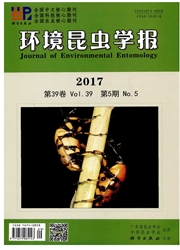

 中文摘要:
中文摘要:
赤拟谷盗与杂拟谷盗形态相似且种间生殖隔离不完全,为探明这两个近缘种之间的遗传分化和系统发育关系,对赤拟谷盗与杂拟谷盗30个个体的一个核基因28S核糖体RNA(28S rRNA)和一个线粒体基因细胞色素氧化酶亚基Ⅰ (COⅠ)进行了PCR扩增、测序和分析,发现这两个基因分别有2个和3个单倍型,种间没有相同的单倍型.在28S rRNA基因区,两个种的种内核苷酸序列均没有变异;在COⅠ基因区,种内核苷酸变异位点不超过2个,且核苷酸变异没有导致其编码氨基酸发生改变.然而,在28S rRNA和COⅠ基因区,种间核苷酸序列分别存在76个和144个位点,且COⅠ基因区的核苷酸变异位点导致25个编码氨基酸发生改变.系统发育分析表明,赤拟谷盗与弗氏拟谷盗和黑拟谷盗的亲缘关系要近于与杂拟谷盗的亲缘关系,这与由其形态推导的系统发育关系并不完全一致.表明,尽管赤拟谷盗与杂拟谷盗形态和大小相似,但其种间的分子遗传分化明显,用28S rRNA和COⅠ基因来评价它们的遗传变异与系统发育关系是非常有用的.
 英文摘要:
英文摘要:
The genetic differentiation and phylogeny of Tribolium castaneum (Herbst) and T. confusum (Jacquelin du Val) are requisite as both species with great morphological similarities and incomplete reproductive isolations. To evalu- ate them, one region of nuclear 28S ribosomal RNA (28S rRNA) gene (1 072 bp) and one region of mitochondrial DNA encoded-cytochrome c oxidase I (CO I) gene (738 bp) were sequenced for 30 individuals. Total two and three haplotypes were identified for the 28S rRNA and CO I sequences, respectively, and there was no shared haplotype between the two species in both sequences. In the 28S rRNA gene region, there was no intraspecific variation within both Tribolium species. In the CO I zene re~ion, haDlotvDe sequences within species differed from each other by no more than two nucleotide substi-tutions, and the substitutions did not result in the change of encoded amino acids. However, there were 76 and 144 substitutions between haplotypes of 7'. castaneum and T. confusum in the 28S rRNA and CO I regions, respectively, and the substitutions in CO I resulted in 25 encoded amino acids changing accordingly. Phylogenesis incorporating two other Tribolium flour beetle species revealed that, T. cast- aneum was more closely related to T. freemani and T. rna-dens than to T. confusum, which was not completely consistent with the phylogenetic relationships inferred from morphologi- cal data. These results demonstrated that T. castaneum and T. confusum were genetically distinct from each other, even though their morphology and size were very similar, and the 28S rRNA gene and CO I gene might be very useful for evalua- ting their genetic variation and phylogenesis, especially for morphologically similar species.
 同期刊论文项目
同期刊论文项目
 同项目期刊论文
同项目期刊论文
 Molecular identification of Tribolium castaneum and T. confusum(Coleoptera: Tenebrionidae) using PCR
Molecular identification of Tribolium castaneum and T. confusum(Coleoptera: Tenebrionidae) using PCR Genetic relationships between Tribolium castaneum and T. confusum based on mitochondrial DNA sequenc
Genetic relationships between Tribolium castaneum and T. confusum based on mitochondrial DNA sequenc 期刊信息
期刊信息
